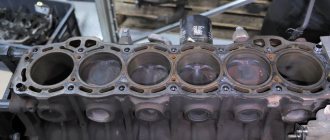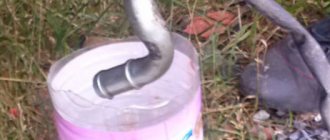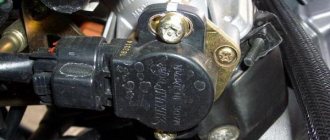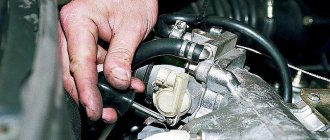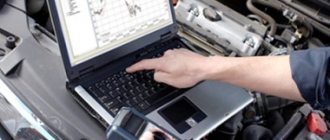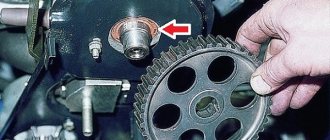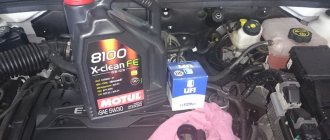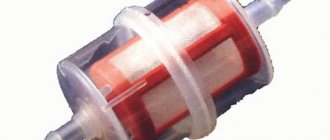By controlling the position of the accelerator pedal, the driver regulates engine speed in a certain gear. Essentially, the gas pedal transmits a signal to the throttle assembly, which, depending on the position of the pedal, regulates the amount of air supplied to the cylinders. The throttle assembly can be electronic or mechanical.
The throttle valve is designed to supply the required amount of air to the cylinders. The throttle is located at the intake manifold. Essentially, this is a unit that meters the amount of air entering the engine per unit of time.
When the unit is working properly, the driver does not think about its operation. However, over time, due to fuel quality, operating conditions and other factors, the throttle valve may require maintenance (cleaning).
Cleaning the throttle body on a Chevrolet Cruze
Why does the throttle valve become dirty?
There are a number of reasons why the throttle valve becomes contaminated with all kinds of deposits. Chief among them is oil dust, which penetrates through the crankcase ventilation pipe from under the valve cover. Oil in the throttle valve settles on all internal surfaces and attracts dirt.
It is impossible to prevent or stop this process. The removal of crankcase gases is necessary, because otherwise the oil will very quickly lose its lubricating properties, and extreme pressure will quickly build up in the lubrication system, and the oil will be squeezed out through all the seals (gaskets, oil seals, oil dipstick). In all engines, crankcase gases are discharged not into the environment, but into the air system to improve the environmental friendliness of the engines.
By themselves, crankcase gases could pass through the throttle valve with virtually no damage to the engine (except for some deterioration in the quality of the working mixture), but their constant companion is oil mist.
Oil attracts the dirty component of gases and, settling on the surfaces of the throttle assembly, forms a deposit that needs to be cleaned.
Let's start to disassemble
On any car, the throttle valve is located at the other end of the pipe that comes from the air filter housing. Since this element always has a large diameter, it is not difficult to find. It is necessary to loosen the fastening clamps using a screwdriver and disconnect it from the damper body. At this stage, you can preliminarily assess the need for cleaning. You can look inside the case and see the degree of contamination. If there is no dark coating, and the walls of the engine housing are clean, then the reason for the unstable operation of the engine lies elsewhere.
If there is visible dirt, then you have two options - partial or complete cleaning. If you don’t want to remove the throttle mechanism completely (or are afraid of breaking something), then you can limit yourself to cleaning the visible part of the mechanism. Simply spray the cleaner through the tube inside the damper body and wipe with a rag to remove excess product and dirt. Repeat this action several times, paying special attention to the end parts of the damper and the walls of the housing. Contamination of these parts has a greater impact on engine performance. Perhaps the result will be noticeable even after such a partial procedure.
Signs that cleaning is necessary
As dirt accumulates, the engine begins to send signals that the throttle valve needs to be cleaned. Signs of a dirty throttle assembly are as follows:
- the engine starts hesitantly, sometimes not on the first try;
- at idle the engine is unstable, the speed fluctuates;
- when driving at low speed (up to 15 km/h), the car jerks;
- when you press the clutch to change gear while driving, the speed either drops very slowly, or, conversely, too sharply, and the engine may stall;
- a dip appears around 1000 rpm.
What is the price?
Cleaning the throttle valve of a VAZ or foreign car is not very different in the technological process (if there is no need to perform throttle training). Therefore, the cost of such a procedure when performed by hand is also the same. All costs come down to the purchase of cleaning fluid. The price of this product is in the range of 80-200 rubles.
The situation changes dramatically if you decide to contact an official dealer to carry out the necessary work. For example, for a Ford Focus 2, cleaning the throttle valve from the “officials” will cost 2,900 rubles. The difference is significant, especially since you will spend one hour on cleaning yourself.
Removing and cleaning the throttle valve
The throttle valve is cleaned after its removal. Removal begins with disconnecting the air duct corrugation and disconnecting the wires from the idle air control and throttle position sensor. The removal itself is not difficult. It is only important that the engine is cold, otherwise you risk getting burns.
The next step is to disconnect the hoses connected to the throttle valve. The disconnected hoses can be plugged with spark plugs so that nothing spills out of them (there's probably an old kit in the garage for this purpose). Finally, you need to remove the cable from the mechanical drive.
After the throttle valve is freed from all “tails”, you can begin to dismantle it and subsequently clean it. It is attached to different machines with two or four bolts or nuts. Then you need to remove the throttle position sensor and idle air control from the throttle assembly, after which you can start cleaning.
How often should I clean?
The cleanliness of both the engine and its body directly depends on the quality of the fuel. The higher the resin content in gasoline, the more often you will have to clean it. On average, the need arises after a mileage of 80-100 thousand. Although on some models of foreign cars such a procedure may be needed much more often. An example of such a car is the Ford Focus. It requires cleaning the throttle valve twice as often.
I am glad that the procedure for processing remote control is simple, and most car enthusiasts will be able to do it themselves. Of course, it won’t do without nuances. But read more about this below.
Fuel systems with electronic air supply control are especially sensitive to damper cleanliness. Due to dirt, the position sensor indicates that the damper is slightly open, but in fact air does not flow in the required volume. Therefore, engine malfunctions begin.
Flushing
Washing is done using a special aerosol for cleaning carburetors. This composition is very aggressive, so you need to clean it carefully. If possible, you should wear gloves and safety glasses. The aerosol is sprayed onto all surfaces and into all channels.
If the dirt is strong, you will have to clean it more than once. The treatment must be repeated after the entire throttle assembly has dried. After all deposits have been washed off, you need to wipe all parts with a clean rag, and, if necessary, rinse again.
Particular attention should be paid to the channel inside which the IAC needle moves and the crankcase ventilation channel, which can become heavily clogged with deposits. The ventilation duct sometimes has to be cleaned using a steel spoke, after which it needs to be cleaned with an aerosol.
Also, careful cleaning is required for the idle air regulator, the needle of which can become so dirty that it begins to jam. However, before flushing, it is advisable to assess the general condition of the IAC. If the needle has a lot of play or wear, it is better to replace the regulator with a new one.
Before installing the throttle assembly back, you need to pay attention to the condition of the gasket. If it is not damaged, it can be reused, but if it is badly damaged or torn, it needs to be replaced. Installation of the throttle assembly is carried out in the reverse order. After assembly, you may need to adjust the throttle valve, or rather, adjust the tension of the cable, which may have weakened or stretched.
Preparation
It is better to carry out cleaning work with a cold engine. The machine doesn't care, but you might get burned. It is also recommended to disconnect the negative terminal of the battery. Especially if you plan to clean the throttle completely without removing it, since you will be disconnecting the connectors and using cleaning fluid. A short circuit is unlikely, but it’s better not to risk it.
Next you need to prepare a simple tool. Regular screwdrivers and a 13mm socket wrench are necessary if you are cleaning the throttle valve 2114 or other domestic equipment. In the case of foreign cars, you may need star-shaped nozzles and the washing liquid itself. Carburetor cleaners are most often used. Please note that this substance is “aggressive”, so do not neglect personal protective equipment (at least gloves).
High engine speed after cleaning the throttle body on a Toyota
You are here: Home >> House, cottage >> High engine speeds after cleaning the throttle body on a Toyota
So, one day I decided to clean the injector and throttle body on my Toyota Fancargo. Well, of course, not by myself, but at a well-known service station in the city.
Moreover, a friend once told me: “When you wash the injector, ask them to also wash the idle air valve, so that the car runs smoothly at idle, so that the speed does not fluctuate.” I called the service station, they explained to me that “it’s probably not the idle air valve, but the throttle valve”? Well, you know better.
In general, everything was done in a couple of hours. According to the master, there was a lot of dirt. The car started up and somehow began to run briskly, you couldn’t keep it in place.
Without pressing the gas pedal, it drives on its own, and even accelerates! Well, I think a simple cleaning of the injector and throttle did wonders for the car.
But it was not there.
The very first stop showed that when the gear lever is moved to the “P” position, the engine speed increases to 2000. What’s the matter? What's the problem? Why is that?
I took a closer look at the symptoms:
- when cold, the engine runs as usual - the rpm is about 1500, then as it warms up, the rpm gradually rises (and should drop) to 2000 per minute - while driving the car just rushes along, you have to constantly slow it down - when stopping at a traffic light rpm drops not to 600, but to 1000 per minute,
- when you turn on the ignition on a warm engine, the speed begins to fluctuate - 1500-1900-1700-2000.
I went online and looked at dozens of sites, starting from Droma and ending with some questions and answers. There was a lot of advice, and I tried almost all of them.
- I removed the battery terminals at night, there was no result, - I pulled the fuse out of the fuse block to reset the block, there was no result, - I drove for two days, about 70 km, there was no result, - I tried to train the engine using different methods, there was no result .
Then I remembered my friend’s advice. And what, I think, was not. I went under warranty to this service station, where they washed my injector and throttle body. And in a mild form he presented to them that, like this, after you flush the throttle valve, the revolutions float and remain at idle about 2000 per minute. It is not good. The guys immediately got down to business. We completely disassembled everything, and behind the throttle valve we “found” the idle air valve. Imagine their surprise that, it turns out, it also needed to be cleaned. After cleaning it, everything returned to normal: the idle speed is 600, when the engine warms up, the needle gradually falls and does not rise, the car does not drive itself, and there is no need to slow it down.
In general, the problem was solved immediately, within 2 seconds.
Note that no adaptation of the throttle valve was required at all, no training after cleaning. As soon as the idle air valve was cleaned, it began to work and began to dose the flow of mixture into the engine.
As I later figured out myself: since previously the throttle valve and idle air valve were clogged, it follows that they were slightly open to ensure normal engine operation. After cleaning the throttle, it began to close well. But the idle valve continued to be open, and when the throttle valve was closed (when the car warmed up), the valve forced the mixture into the engine, which led to high engine speeds.
As soon as the valve was cleaned (note, it must not only be cleaned, but also washed with a high-pressure valve and a drop of oil in it so that it rotates well - for me it turned with difficulty), the computer itself adjusted everything within 2 seconds, everything I adapted it myself and learned it myself. I just sat down and drove off, and put this problem out of my mind.
PS But sometimes even cleaning the throttle valve and idle air valve does not help. The engine continues to run at high speeds, and the brake pedal becomes stiff and wooden. In this case, the VVTi valve is to blame - read how to clean the VVTi valve yourself.
So, advice to those who have a problem with high engine speeds after washing the throttle valve - wash the idle air valve.
And further. Sooner or later, everyone experiences a hum in the wheel when accelerating. In these cases, be sure to check the wheel bearing (read the article: https://sebe-na-zametku.ru/142-prichina-gula-v-mashine-pri-dvizhenii-i-nabore-skorosti-reshenie-problemy.html)
Victor Sharifullin specially for the website Sebe-na-zametku.ru 08/07/2014
What does cleaning the throttle valve do and how to adjust the throttle
The throttle valve or throttle is a unit that serves to regulate the amount of air entering the cylinders of the internal combustion engine. The degree to which the accelerator pedal is pressed will determine how far the said damper opens. On modern fuel-injected cars, the electronic engine control unit (ECU) determines the position of the throttle valve and the volume of air entering the power unit using sensors, after which it sends a control signal to the injectors/gasoline pump to supply the required amount of fuel, which will be proportional to the amount of incoming air.
Cleaning the throttle valve on the injector of a gasoline engine, as well as cleaning the throttle valve on a diesel engine, is a necessary procedure, since contamination of this unit leads to unstable engine operation. If the throttle is dirty, the power unit may idle unevenly, the speed may fluctuate, reactions to pressing the gas pedal may be slow, fuel consumption increases, failures occur during acceleration, etc. In our article we will talk about what it involves to clean the throttle yourself, how to properly adjust the throttle (throttle adjustment, training, adaptation), as well as what fluid to use for cleaning the throttle.
The throttle valve is dirty: reasons
During vehicle operation, throttle contamination is inevitable. At the same time, on a working internal combustion engine, even without regular cleaning, dirt, which leads to certain problems, appears after 25-40 thousand km. mileage The process may be accelerated for the following reasons:
- Use of low quality air filters or loss of air tightness in the intake. For example, it is enough for a crack to appear in the air filter housing or for defects in the air supply pipe to appear.
- Another reason for accelerated throttle contamination is the forced crankcase ventilation system. Some car models with this system are designed so that gases from the crankcase, together with particles of engine oil, are not supplied to the intake manifold, but to the pipe through which air is supplied. The specified pipe is located just in front of the throttle. A certain amount of oil is retained by the oil separator, while the remainder accumulates on the valve.
As a result, due to adhering oil and dust, the damper does not close well, and the device may jam. That is why it is recommended to clean the damper for preventive purposes every 10 thousand km, that is, during a scheduled oil and filter change.
Throttle Body Cleaner
In order to clean the throttle valve, a carburetor cleaner (the so-called “carbicleaner”) is perfect. These compositions allow you to effectively wash away dirt and deposits in just a few minutes. It is preferable to clean the throttle valve by removing it, which allows you to wash away deposits, after which they will not end up in the engine cylinders. After applying the cleaner, you need to use a soft brush or brush, which carefully removes any remaining dirt, then the throttle assembly is additionally blown with air from the compressor.
After cleaning the throttle body the speed fluctuates
So, it would seem that the whole procedure is over. The damper was cleaned with a cleaner, the air filter was replaced with a new one, the sensors were reconnected, that is, everything was assembled and tightened. Now you can proceed to starting the engine. If the engine starts after cleaning the throttle valve and then runs normally, then the procedure can be considered successful.
It should be added that this is not always the case. Many people are faced with the fact that after cleaning the throttle valve, high engine speeds remain constant and do not drop. Also, many drivers notice that after cleaning the throttle valve, fuel consumption has increased. A likely cause could be an error in connecting some sensor during reassembly, but this rarely happens.
Most often, after cleaning, the throttle also needs to be additionally calibrated and adjusted, which not everyone knows about or does it incorrectly. In other words, high idle speeds after cleaning the throttle valve are a clear example and at the same time an answer to the common question of whether the throttle valve needs to be trained after cleaning this unit. Let's figure it out.
Let's start with the fact that in some cases a pure throttle valve really needs to be adapted (trained). Typically, throttle valve adaptation is often necessary when the electronic throttle valve has been cleaned before. There are fewer problems with a mechanical damper, but they still exist. In systems with an electronic throttle, the ECU independently sets the throttle position; in mechanical systems, the idle air control is set. To put it simply, after removing the layer of dirt, the position of the cleaned damper changes, but the ECU does not know about this and continues to supply fuel in accordance with the previous parameters before cleaning. To solve the problem, it is necessary to set the idle speed using diagnostic equipment, since it is possible to reset the previous parameters.
You can also try teaching the throttle manually. The simplest way to learn without diagnostic equipment or a scanner for adaptation is to unscrew the negative terminal of the battery from a few seconds to 10 minutes (depending on the make and model of the car). This allows you to reset the settings, that is, the existing adaptation is reset and returned to the factory settings. After connecting the terminal to the battery and restarting the engine, the idle speed should stabilize.
Note that this method works on a limited number of cars. In such a case, you can take advantage of another opportunity to train the throttle assembly without a computer. This method is suitable for a range of vehicles from different manufacturers. Let's consider such an adaptation using the example of a Japanese Nissan car.
- First, the engine must be warmed up to operating temperature, after which the engine should be turned off.
- Next, you will need to wait 5-10 seconds, then turn on the ignition for 3 seconds.
- Now you need to press the gas pedal all the way and immediately release it. This is done 5 times, you need to do it in 5 seconds (one press per second). The interval should be timed using a stopwatch so as not to get lost.
- After the last press, you should wait 7 seconds, after which the gas pedal is again pressed “to the floor” and held in this position until the “check” begins to blink on the dashboard, and then this light comes on constantly.
- After the moment when the check code starts to light up constantly, you need to wait another 3 seconds. Now the gas pedal can be released.
- Next, the engine needs to be started, the idle speed should return to normal.
Let us add that during such adaptation of the throttle valve it is important to accurately maintain the timing at each stage, as well as to fit into all time intervals. In this case, we can talk about successful training. It is also recommended to clarify the features and the possibility of manual adaptation for a specific car model.
After cleaning the throttle body the check light came on
On some cars, the damper is sprayed, as it is covered with a special molybdenum paint applied around the perimeter of the damper. If you clean the damper too vigorously, then there is a risk of removing this coating. Without it, normal throttle operation is disrupted. The paint can be purchased separately, after which the coating must be restored. Another nuance may be the natural wear of the throttle valve, that is, the surface wears out on its own, taking into account the fact that opening and closing occurs. At the ends, accumulated dirt grinds down the damper, after which a gap appears. Before cleaning, the gap is clogged with deposits, but after removing them, the development immediately makes itself felt.
If the gap is large, then the idle speed control control systems malfunction. Normally, a small amount of air flows through the damper, which is in the closed position. Air also passes in a minimal amount through the small gap that exists between the ends of the “patch” and the walls of the throttle assembly. This air is taken into account by the ECU during idle adjustment, the idle regulator sets the desired step and the speed is still maintained within the specified limits.
Assembly
We assemble in reverse order. Check that the cooling hose and air hose clamps are properly tightened. Tighten the damper housing bolts firmly, but not fanatically. Be sure to check the condition of the air filter and replace if necessary.
The car may not start the first time. This is caused by treatment fluid remaining in the channels. Cleaning your Ford throttle body will cause the engine to run rough (for a while). But the motor control unit quickly adapts to the new position, and operation stabilizes.
